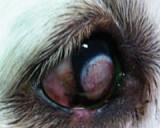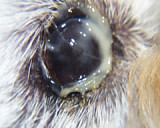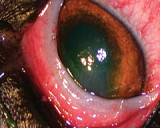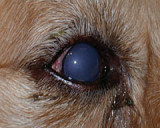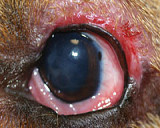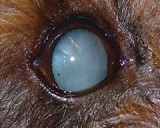Feline glaucoma is harder to recognise compared to canine glaucoma for both the owner and the vet. Whilst dogs usually presents with the ACUTE RED and BLUE eye cats usually present with slower, insidious, chronic signs. This article will discuss common clinical signs, causes and treatment plans for cats with glaucoma.
Clinical signs
1. Deep perilimbal hyperaemia - infrequent
2. Corneal oedema – variable in the acute stages more commonly seen in the later stages
3. Globe enlargement – commonly seen with inability to close the eyelids and central corneal ulcer due to exposure
4. Vascularisation of the cornea is variable
5. Blindness
6. Mydriasis - negative pupillary light reflex
7. Lens subluxation or luxation
8. Anterior uveitis
9. Elevated intraocular pressure (normal intraocular range is 10-25 mmHg in cats) - Ideal use a tonopen or tonovet
10. Retinal changes – very difficult to see changes in the retina and optic nerve compared to the dog


Causes
Congenital – uncommon
Primary – Siamese and Burmese
Secondary – is the most common form of glaucoma
Anterior uveitis – inflammatory cells or pre-iridal fibrovascular membranes blocking the outflow of the aqueous humor from the eye
Intraocular neoplasia – diffuse iris melanoma, lymphoma
Trauma – hyphaema and inflammatory cells, penetrating injury to the lens
Anterior lens luxation – often associated with chronic uveitis
Shallow anterior chamber syndrome
UVEITIS IS THE MOST COMMON CAUSE OF GLAUCOMA IN CATS
Treatment
Medical management is the principal way of controlling intraocular pressure and maintaining comfort. The uveitis must be managed as well as the glaucoma.
Uveitis and glaucoma medical management
Topical cortisone drops: Prednisolone acetate (Prednefrin Forte®) or Dexamathasone eye drops (Maxidex®) are extremely effective but some studies have shown a percentage of cats developing elevated intraocular pressure with long term use. Regularly recheck the intraocular pressure and avoid if ulceration in present. Topical NSAID drops: Diclofenac 0.1% (Voltaren®) is also every effective. Avoid if corneal ulceration is present.
Systemic anti-inflammatory therapy: oral cortisone or NSAID depending on the health of the cat and the individual case. Treating the uveitis is very important as it is usually the underlying cause.
Topical carbonic anhydrase inhibitors: Dorzolamide (Trusopt®). These are the mainstay of glaucoma treatmenet in cats. These are used twice to three times daily depending on IOP readings.
Prostaglandin antagonists like latanoprost (Xalatan®) are not effective in reducing intraocular pressure but can cause marked constriction of the pupil. Osmotic Agents – Rarely used and can have significant systemic side effects.
Glaucoma surgical management
Once a cat’s eye develops buphthalmos (is enlarged) it is blind. Medical management can be attempted if the IOP is less than 35mmHg and may be successful and avoid the need for eye removal. If the eye is enlarged and the IOP is not responding to therapy, eye removal is recommended.
IT IS RECOMMENDED THAT ENUCLEATION OF AN ENLARGED CAT’S EYE BE PERFORMED BY AN EYE SPECIALIST.
Removal of an enlarged cat’s eye can result in the patient waking up blind due to damage to the optic nerve on the fellow eye. The optic nerve has little give in a cat, and it is essential that NO pressure be applied on the globe when it is removed, to prevent damage to the optic nerve at the chiasm.
Pathology should be performed if the underlying cause of the glaucoma is suspected to be neoplasia.
